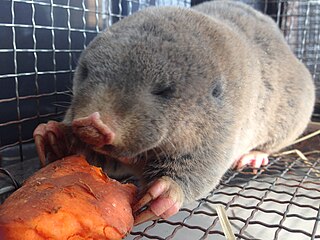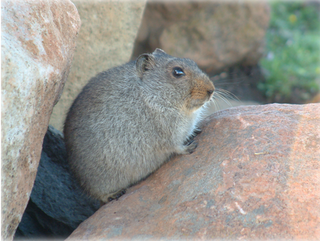
The Muroidea are a large superfamily of rodents, including mice, rats, voles, hamsters, gerbils, and many other relatives. They occupy a vast variety of habitats on every continent except Antarctica. Some authorities have placed all members of this group into a single family, Muridae, due to difficulties in determining how the subfamilies are related to one another. The following taxonomy is based on recent well-supported molecular phylogenies.

Zokors are Asiatic burrowing rodents resembling mole-rats. They include two genera: Myospalax and Eospalax. Zokors are native to much of China, Kazakhstan, and Siberian Russia.

Mouse-like hamsters are a group of small rodents found in Syria, Azerbaijan, Iran, Turkmenistan, Afghanistan, and Pakistan. They are found in rocky outcrops and semi-mountainous areas in desert regions.

The Cricetidae are a family of rodents in the large and complex superfamily Muroidea. It includes true hamsters, voles, lemmings, and New World rats and mice. At almost 608 species, it is the second-largest family of mammals, and has members throughout the Americas, Europe and Asia.

The Spalacidae, or spalacids, are a family of rodents in the large and complex superfamily Muroidea. They are native to eastern Asia, the Horn of Africa, the Middle East, and southeastern Europe. It includes the blind mole-rats, bamboo rats, mole-rats, and zokors. This family represents the oldest split in the muroid superfamily, and comprises animals adapted to a subterranean way of life. These rodents were thought to have evolved adaptations to living underground independently until recent genetic studies demonstrated they form a monophyletic group. Members of the Spalacidae are often placed in the family Muridae along with all other members of the Muroidea.

The Nesomyidae are a family of African rodents in the large and complex superfamily Muroidea. It includes several subfamilies, all of which are native to either continental Africa or to Madagascar. Included in this family are Malagasy rats and mice, climbing mice, African rock mice, swamp mice, pouched rats, and the white-tailed rat.

The Eumuroida are a clade defined in 2004 by Steppan et al. that includes rats, mice and related species, though not all rodents; in other words, a specific group of muroid rodents. The clade is not defined in the standard taxonomic hierarchy, but it is between superfamily and family.

Pouched rats are a group of African rodents in the subfamily Cricetomyinae. They are members of the family Nesomyidae, which contains other African muroids such as climbing mice, Malagasy mice, and the white-tailed rat. All nesomyids are in the superfamily Muroidea, a large and complex clade containing 1⁄4 of all mammal species. Sometimes the pouched rats are placed in the family Muridae along with all other members of the superfamily Muroidea.

Dendromurinae is a subfamily of rodents in the family Nesomyidae and superfamily Muroidea. The dendromurines are currently restricted to Africa, as is the case for all extant members of the family Nesomyidae. The authorship of the subfamily has been attributed to both Alston, 1876, and (incorrectly) to G. M. Allen, 1939.

The genus Spalax contains the blind, fossorial, or subterranean mole rats, which are one of several types of rodents that are called "mole rats". The hystricognath mole-rats of the family Bathyergidae are completely unrelated, but some other forms are also in the family Spalacidae. Zokors, root rats, and bamboo rats are spalacids sometimes referred to as mole rats. Blind mole rats are in the family Spalacidae, but are unique enough to be given a separate subfamily, Spalacinae. Alternate opinions on taxonomy consider the blind mole-rats to be the only members of the family Spalacidae and rank other spalacid subfamilies as full families. Other authors group all members of the superfamily Muroidea into a single family, Muridae. The Spalacinae contains two genera and eight species. Some authorities treat all species as belonging to a single genus, Spalax.

The Malagasy rats and mice are the sole members of the subfamily Nesomyinae. These animals are the only native rodents of Madagascar, come in many shapes and sizes, and occupy a wide variety of ecological niches. There are nesomyines that resemble gerbils, rats, mice, voles, and even rabbits. There are arboreal, terrestrial, and semi-fossorial varieties.

The suborder Myomorpha contains 1,137 species of mouse-like rodents, nearly a quarter of all mammal species. Included are mice, rats, gerbils, hamsters, lemmings, and voles. They are grouped according to the structure of their jaws and molar teeth. They are characterized by their myomorphous zygomasseteric system, which means that both their medial and lateral masseter muscles are displaced forward, making them adept at gnawing. As in the hystricognathous rodents, the medial masseter muscle goes through the eye socket, a feature unique among mammals. Myomorphs are found worldwide in almost all land habitats. They are usually nocturnal seed-eaters.
The Chapa pygmy dormouse or Vietnamese pygmy dormouse is a rodent endemic to Vietnam. It is listed as a critically endangered species. It is often considered a separate species, but is now recognized as a subspecies of the Chinese pygmy dormouse.

The Togo mouse, also known as Büttner's African forest mouse or the groove-toothed forest mouse, is a unique muroid rodent known from only two specimens taken from near the type locality of Bismarckburg, near Yege, Togo, in 1890. Its genus is monotypic.

The Malabar spiny dormouse is a species of muroid rodent endemic to the Western Ghats of India. It is the only extant species in the genus Platacanthomys and although resembling a dormouse, it is not closely related. About the size of a brown rat, this arboreal species lives in tree holes in dense forest habitats in a small family group. They are distinguishable from other species in the area by their bushy tuft tip to the tail and the spiny fur on the back.

Delany's mouse or Delany's swamp mouse is a species of rodent in the family Nesomyidae. It is the only species in the genus Delanymys and the only extant member of subfamily Delanymyinae, which also contains the fossil genus Stenodontomys. It was previously placed in subfamily Petromyscinae, but it is apparently not closely related to Petromyscus. It is found in Democratic Republic of the Congo, Rwanda, and Uganda. Its natural habitats are subtropical or tropical high-altitude shrubland and swamps. It is threatened by habitat loss.
Petromyscus is a genus of rodent in the family Nesomyidae. It is so distinct from other rodents that it is placed as the only genus in subfamily Petromyscinae. In previous classifications, Delanymys brooksi has also been placed in the subfamily. They are found in southwestern Africa. These animals have a sharp lower point to their V-shaped infraorbital canal. Their molars are intermediate between the ancestral cricetid style tooth and the dendromurine style tooth.

The Chinese pygmy dormouse is a species of rodent of the family Platacanthomyidae found in China and Vietnam.
Hotson's mouse-like hamster also known as Hotson's calomyscus or Hotson's brush-tailed mouse is a species of rodent in the family Calomyscidae. It is endemic to southwestern Pakistan and southeastern Iran.

Otomyini is an Old World tribe of muroid rodents in the subfamily Murinae. Musser and Carleton (2005) granted it subfamily status (Otomyinae), but molecular studies consistently show that the otomyines evolved from within the Murinae, leading these researchers to subsume it in this subfamily, sometimes with tribal status. It includes 3 genera.

















